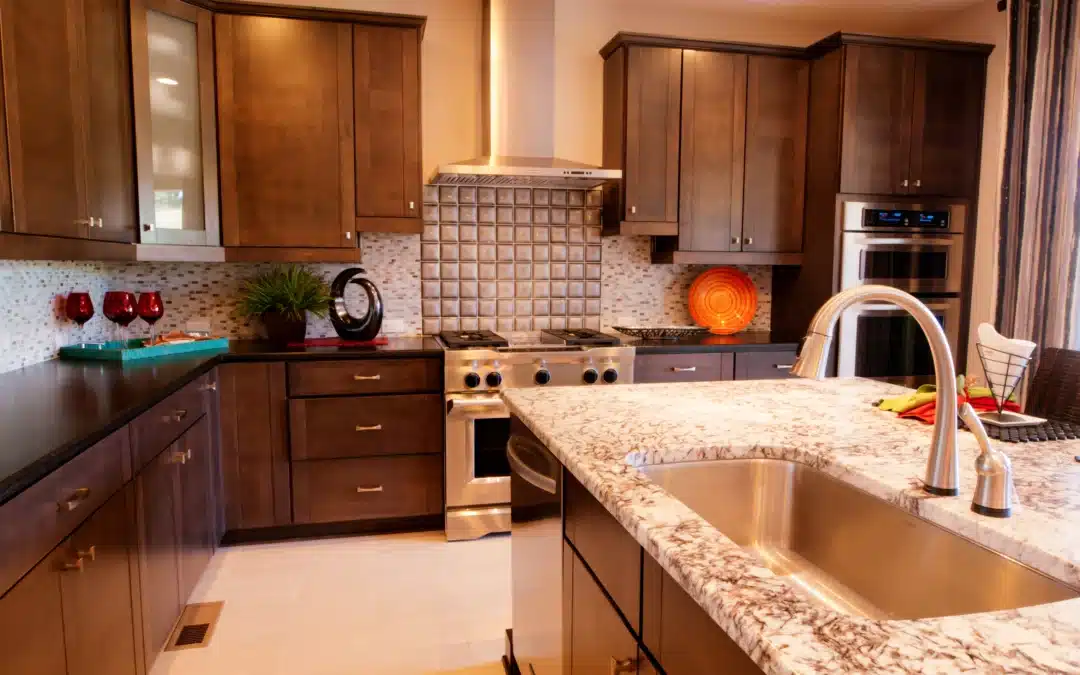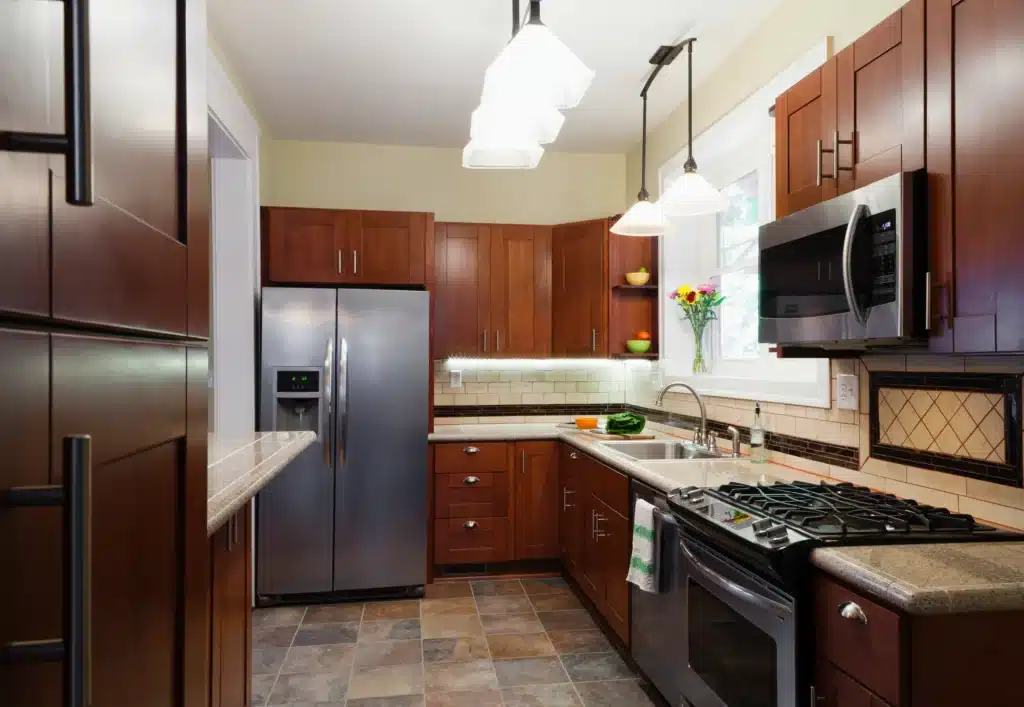
When Remodeling a Kitchen, What Comes First?

Kitchen remodeling is exciting, but the question “when remodeling a kitchen, what comes first?” is a common question among homeowners.
Many feel unsure about where to begin, and that’s completely normal. At Floors Pros, we help families plan their projects the right way so they can enjoy a smooth kitchen remodel beginning to end. Knowing the correct sequence saves time, prevents mistakes, and helps you stay within your remodeling budget.
Below, we break down the correct order for a kitchen renovation, outline the steps you shouldn’t skip, and provide guidance on how to tackle a kitchen remodel with confidence.
Why the Right Order Matters in a Kitchen Remodel
A remodeling project involves many moving parts, which include plumbing and electrical work, flooring installation, cabinetry, countertops, and more. When you follow the correct sequence, you prevent delays, protect your materials, and make sure inspections pass the first time.
Here’s what the right order helps you avoid:
- Damaging new flooring when installing cabinets
- Installing countertops before the plumbing is ready
- Tearing out drywall after the electrical work was missed
- Wasting money by redoing steps out of order
Planning is the “hidden” part of a successful kitchen renovation, but it makes a huge difference in the final results.
Step-by-Step—What Comes First When Remodeling a Kitchen
Below is the ideal order of a kitchen remodel, whether you’re undertaking a major overhaul or simply giving your space a fresh look.
1. Create Your Design Plans and Set Your Budget
Before any work starts, you want a clear vision of your:
- Kitchen layout
- Cabinet style
- Countertop material
- Flooring type
- Appliances
- Backsplash design
- Fixtures
Your overall design sets the direction for every step that follows.
This is also the time to decide:
- How much do you want to invest
- What upgrades matter most
- Whether you want a temporary kitchen during the renovation
2. Clear Out Your Kitchen
Removing personal items makes space for the prep work. You can:
- Set up a temporary kitchen in another room
- Store dishes and small appliances
- Move furniture out of the way
A clean space helps your contractor start faster and safer.
3. Demolition Comes First
This is where the real transformation begins.
Demolition may include:
- Removing old cabinets
- Taking out outdated flooring
- Pulling down damaged drywall
- Disconnecting appliances
- Removing countertops
Doing clean and safe demolition ensures the next steps go smoothly.
4. Plumbing and Electrical Rough-In Work
Once everything is open, it’s time for the rough-in work:
- Plumbing lines
- Electrical wiring
- Gas lines
- Venting
- Lighting layout
This step must be done before closing the walls. It’s also when you finalize placements for:
- New appliances
- Refrigerator line
- Stove location
- New lighting
This part requires licensed pros. When hiring a contractor, ensure they are familiar with the local code requirements.
5. Inspection of Plumbing and Electrical
Before moving forward, the city may require an inspection. Passing now prevents costly fixes later.
6. Drywall and Painting
Once everything behind the walls is ready, your crew will:
- Patch drywall
- Add new drywall if needed
- Smooth and prep walls
- Paint the space
Getting the walls finished early protects your new cabinets and countertops from damage.
7. Install Cabinetry
Now it’s time for kitchen cabinets. This step sets the structure for everything else, including:
- Countertop measurement
- Appliance placement
- Backsplash height
This is why cabinets come before most other steps in the kitchen remodeling process.
8.Countertops and Fixtures Installation
After the cabinets are set, professionals can install:
- Countertops
- Sink
- Plumbing fixtures
- Lighting fixtures
- Kitchen hardware
This brings your new kitchen to life.
9.New Flooring Installation (Depending on Your Project)
Some homeowners ask: “Should I install new flooring before or after cabinets?”
Here’s the rule:
Floating floors (like LVP, engineered wood, and some vinyl):
→ Install them after the cabinets.
Tile flooring or glue-down floors:
→ Can be installed before cabinets, depending on your layout.
If you’re unsure, work with a contractor to choose the best order for your space.
10. Backsplash, Touch-Ups, and Finishing Details
These finishing touches complete your space:
- Backsplash installation
- Final paint
- Hardware
- Trim
- Sealants
- Final cleaning
This is where your space transitions from “under construction” to a fully realized kitchen transformation.
Correct Order Summary — What Comes First When Remodeling a Kitchen
Here’s the entire kitchen renovation timeline in one simple list:
- Make design plans & set your remodeling budget
- Remove items & set up a temporary kitchen
- Demolition
- Plumbing and electrical rough-in
- Inspection
- Drywall and paint
- Install cabinets
- Add countertops, sink, and fixtures
- Install new flooring (based on material type)
- Backsplash, trim, and finishing touches
Following this sequence gives you a smooth and successful kitchen remodel with no wasted time or money.
FAQs About the Right Order for a Kitchen Remodel
1. When remodeling a kitchen, what comes first, floors or cabinets?
Cabinets typically come first. However, some types of flooring, such as tile, can be installed under cabinets, depending on the project.
2. What should I replace first in a kitchen remodel?
The first major step is demolition, followed by plumbing and electrical rough-in work.
3. Should appliances be installed before or after cabinets?
Most appliances are installed after cabinets and countertops, except for built-in units, which must be measured during cabinet installation.
4. Do you install countertops or backsplash first?
Countertops come first, followed by the backsplash, for a clean, even finish.
5. How long does the remodeling process take?
A moderate kitchen remodel project usually takes 4–8 weeks, depending on the scope of your makeover.
6. Do I need to move out during a kitchen remodel?
No, but having a temporary kitchen helps make the process easier.
7. What is the best way to remodel a kitchen on a budget?
Start with a clear plan, choose materials that match your needs, and hire a professional to avoid costly mistakes.
Ready to Start Your Kitchen the Right Way?
If you want a smooth, stress-free experience and a kitchen that fits your style, Floors Pros is here to help. Our team handles every detail—from kitchen design to the installation of cabinets, countertops, and new flooring—so your project runs smoothly from start to finish.
We proudly serve Allen, TX, and surrounding areas, offering:
Remodeling Services:
- Interior Remodeling
- Kitchen Remodel
- Bathroom Remodel
- Shower Remodel
- Countertops
- Home Painting
Flooring Services:
- Tile
- LVP
- Vinyl
- Carpet
- Wood
- Engineered Wood
- Stairs
Let’s build the kitchen of your dreams.
Get expert remodeling service only from the best. Call us at (469) 972-9229 to book your appointment, or visit our shop today at 753 Apollo Ct, Allen, TX 75002. Floors Pros is here to give your kitchen the fresh start it deserves. Get a quote today.
Also Read:
Ready for a Stunning Remodel? Find Home Remodeling Services Near Me!
